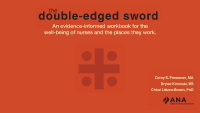How to create the conditions for career success when life throws you a curve ball
Takeaways:
- Timing plays a more significant role in work and life than we sometimes acknowledge.
- Life sometimes throws us curveballs that force us to re-examine our career trajectories.
- Leaders must know when the timing is right for their leadership and when it might not be.
CASEY* manages a large critical care unit. She’s the youngest director in her health system and is considered a leadership superstar on a fast track to a chief nursing officer (CNO) position. However, recent events in her personal life have led her to reconsider her current career path. Within a span of 6 months, she gave birth to her first child, and her mother, who lives next door, was diagnosed with early-onset Alzheimer’s disease. Casey is finding it impossible to meet the demands of work and her family. She’s always been career driven and goal oriented but now wonders if the timing just isn’t right to forge ahead with a busy leadership career.
*Name is fictitious
What Casey is experiencing isn’t that unusual. Until now, she felt in charge of her life and career. She had well-laid plans and was on a clear path to achieve them. However, life has a way of throwing us curve balls. When this happens, even a carefully devised plan may not seem doable. Leaders then struggle with the options because we don’t want to fall behind in our career. We begin to realize that complete control is an illusion.
Casey is learning that timing plays a more significant role in work and life than we sometimes acknowledge. If we understand this, we can more readily accept that things don’t always unfold in the order that we’d like. There may be reasons bigger than us as to why something happens, and it may, in fact, be to our advantage. When Steve Jobs addressed the 2005 graduating class at Stanford University, he noted that “You can’t connect the dots looking forward; you can only connect them looking backward. So, you have to trust that the dots will somehow connect in your future. You have to trust in something—your gut, destiny, life, karma, whatever. This approach has never let me down, and it has made all the difference in my life.”
In this article, we’ll look at the role timing plays in both life and work and offer strategies you can use when confronted with challenging career decisions in the face of changing life events.
Timing in life
Casey has found herself in a common life predicament. Harvard researchers studying the future of work found that three-quarters of U.S. workers are caregivers for at least one dependent person (a child, an elderly relative, or an ill spouse). The researchers also found that higher-titled and responsible employees like Casey may be especially affected by caregiving conflicts. Having a demanding career and caregiving responsibilities can leave leaders torn between choosing one over the other. What makes Casey’s situation more challenging than some is that she’s both a nurse and a woman, which can lead to higher expectations and pressure to manage both her caregiving responsibilities and leadership role seamlessly.
Casey’s new life events are transitioning her role identity to include caregiving. If Casey can embrace this change as part of timing in life, she doesn’t need to feel bogged down by thinking she has many opposing obligations. Instead, she can harness her caregiver identity as her ambition, at least for the present. Based on Bear’s Caregiving Ambition Framework, Casey needs to find a balance between her feelings of work-life conflict versus the enrichment of being a caregiver. By self-advocating and creating this balance, she can maintain her career ambition without feeling she’s compromising too much on her caregiver identity.
 As a young new director who’s been labeled a leadership superstar, Casey has earned a good reputation. An essential step moving forward is finding ways to leverage these strengths and foster them to her advantage. Part of being a successful leader is coaching others and developing their skills through delegation. So, Casey must take a step back and examine the critical care environment she’s leading to determine who are her clinical experts and informal leaders. She can then focus some of her time on mentoring these invaluable employees so that they can be groomed to mentor other nurses on the unit and lead practice and patient quality-driven projects. Though this might require Casey to step up more at work to effectively mentor these nurses, in the long run, she’ll be able to confidently delegate appropriate responsibilities, leading to a more supportive transformational leadership role. And she’ll probably reap the benefits of a more engaged staff who are invested in optimizing quality patient care and a healthy work environment.
As a young new director who’s been labeled a leadership superstar, Casey has earned a good reputation. An essential step moving forward is finding ways to leverage these strengths and foster them to her advantage. Part of being a successful leader is coaching others and developing their skills through delegation. So, Casey must take a step back and examine the critical care environment she’s leading to determine who are her clinical experts and informal leaders. She can then focus some of her time on mentoring these invaluable employees so that they can be groomed to mentor other nurses on the unit and lead practice and patient quality-driven projects. Though this might require Casey to step up more at work to effectively mentor these nurses, in the long run, she’ll be able to confidently delegate appropriate responsibilities, leading to a more supportive transformational leadership role. And she’ll probably reap the benefits of a more engaged staff who are invested in optimizing quality patient care and a healthy work environment.
In addition to cultivating her employees as a team, Casey must practice what she’s preaching by remembering that being a leader doesn’t mean you lead in a silo but instead you’re part of a leadership team. She needs to reach out to the CNO to voice her desire to maintain an enriching versus conflict-driven work-life balance. This should include co-creating a plan with the CNO that includes a flexible work schedule and an effective means of defining and using work time based on quality rather than quantity. This will provide Casey with the flexibility to be a present caregiver to her mother and newborn while still maintaining quality leadership of the critical care unit.
Organizations achieve a strong return on investment when they commit to helping employees manage caregiving responsibilities. By supporting Casey to create an innovative and flexible work environment using strategies that maximize technology, building informal mentorship and evidence-based practice teams led by direct patient care nurses, and offering flexible weekly work schedules, the CNO will retain an engaged leader. In the end, it’s not about choosing one over the other or deciding to be mediocre at both; it’s about finding a work-life balance that maintains a strong caregiver identity that’s enriching and satisfying. In the bigger picture of life, this intense experience with the caregiving challenges can help shape Casey’s ideas about leadership and building a caring work environment that supports staff needs.
Timing at work
Although Casey may learn to navigate her work expectations successfully in her current position, the day will probably come when she’s offered a leadership role that demands more of her time. When this happens, Casey will need to decide whether she should step up to a new position or hold back from assuming more responsibility. Leadership expert John Maxwell identifies the law of timing as one of 21 irrefutable laws of leadership. He observed that timing often spells the difference between success and failure. Good leaders recognize that making decisions about when to lead is critical. Developing a good sense of timing in your work and life is a vital nursing leadership strategy. Casey can use these questions to guide her decision-making.
1 Do I have a good grasp on the expectations of the new position and organization?
Many leadership roles are quite demanding, especially during the initial transition. Some organizations have cultures that support caregiving through flexible scheduling and others don’t. Will the job requirements expect that you work late or come in early for meetings? Astute nurse leaders carefully study their organizational cultures and understand what’s happening in their environments as they consider career advancement.
2 What are the competing factors in my life that could influence my success?
Casey’s caregiving responsibilities will probably ebb and flow according to the needs of her child and mother. An essential part of navigating this challenging situation is developing a robust support system. As she looks at future career opportunities, Casey will need to consider competing factors for her time and how they might impact a successful transition to a higher level of leadership.
3 Do I have the experience to take on this role now and the confidence of those who may be impacted by my caregiving responsibilities?
The right action at the right time by the right leader can result in incredible success. Winston Churchill was a classic example of this type of leadership during World War II. In describing his leadership during that time, he said, “There comes a special moment in everyone’s life, a moment for which that person was born. That special opportunity when he seizes it, will fulfill his mission—a mission for which he is uniquely qualified. In that moment, he finds his greatness. It is his finest hour.” In your role as a leader, times will arise when you need to decide whether you’re the right person to accept a specific leadership role, drive a change in an organization, or implement a new project. The answer may be yes, but it also may be no. For Casey, she will need to know that she has the confidence and support of those who may be affected by her caregiving responsibilities. Leaders must have the wisdom to know when the time is right for their leadership.
4 Can I create the conditions for success?
Casey will need to consider whether she can create the conditions for success if she chooses to take a different leadership role. Leaders learn through experience the importance of timing in their work and lives but may not be as aware of the evidence surrounding it. In his book When: The Scientific Secret of Perfect Timing, Daniel Pink uses cutting-edge research to explain how we can use timing to our advantage. His findings have important implications for work, including that we do certain kinds of work better in the morning. Research indicates that we tend to move through the day in three stages—peak, trough, and recovery. Most of us move through it in that order; night owls go in the reverse order. This information is important for a leader like Casey because maintaining her energy level and avoiding burnout may prove challenging. During the peak, we’re better at analytic work, work that requires heads-down focus, vigilance, attention, and batting away distractions. Research points to the importance of lunch breaks (often skipped in healthcare settings) to allow for detachment, which is critically important to occupational health and well-being, especially for those in cognitively or emotionally demanding jobs. Short (20-minute) naps also have been found to be restorative. This kind of evidence could help Casey create conditions for success in her new role.
5 Have I carefully listened to my intuition about the timing of this decision?
Leaders can be very excited about new career opportunities but know in their gut that the timing might not be right. It takes reflection and courage to put the brakes on a career move that looks like an exceptional opportunity to the outside world but may not be right for you because of other responsibilities. Even Sheryl Sandberg, the chief operating officer at Facebook, learned through her tragic life events that leaning in, which she always recommended, is sometimes not the right thing to do.
Navigating challenges
Casey is navigating challenging circumstances in her life and career. Setting realistic expectations at home and work are key to maintaining her sanity as a caregiver and nurse leader.
Leaders need to know when the time is right for their leadership and when it may not be. Rather than seeing this as the end of the road on what had been a fast-track leadership career, Casey needs to look at it as a fork in the road. Ultimately, this experience may lead her to evolve into a more authentic and empathetic leader.
Rose O. Sherman is professor emeritus at Florida Atlantic University in Boca Raton, Florida, and author of the book The Nurse Leader Coach: Become the Boss No One Wants to Leave. You can read her blog at emergingrnleader.com. Tanya M. Cohn is an associate professor of practice and consulting nurse scientist at Simmons University in Boston, Massachusetts.
Selected references
Bear JB. The caregiving ambition framework. Acad Manage Rev. 2019; 44(1):99-125.
Churchill W. Churchill: The Power of Words. Boston, MA: Da Capo Press; 2012.
Fuller JB, Raman M. The caring company: How employers can cut costs and boost productivity by helping employees manage caregiving needs. Harvard Business School. 2019 hbs.edu/managing-the-future-of-work/research/Pages/the-caring-company.aspx
Maxwell JC. The 21 Irrefutable Laws of Leadership: Follow Them and People Will Follow You. New York, NY: HarperCollins Leadership; 2007.
Pink DH. When: The Scientific Secrets of Perfect Timing. New York, NY: Riverhead Books; 2018.
Sandberg S, Grant A. Option B: Facing Adversity, Building Resilience, and Finding Joy. New York, NY: Knopf; 2017.
Sherman RO. Why timing is crucial in leadership. Am Nurse Today. 2014;9(9):14-15, 44. myamericannurse.com/timing-crucial-leadership
‘You’ve got to find what you love,’ Jobs says. Stanford News. June 14, 2005. news.stanford.edu/2005/06/14/jobs-061505/


















